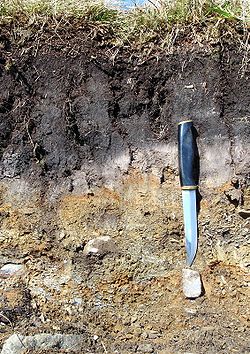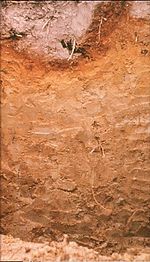- Podzol
-
Podzol Podsol, Spodosol 
a stagnopodzol in upland Wales Used in: WRB, USDA soil taxonomy, others WRB code: PZ Profile: O(Ah)EBhsC Key process: podzolization Parent material: quartz rich debris and sediments Climate: humid continental, subarctic, other Horizons H: common
O: always, has humified organic matter mixed with minerals
A: absent in most boreal podzols[1]
E: common, is ashen grey and leached in Fe and Al
B: always, receives Fe and Al through illuviation
C: commonIn soil science, podzols (also known as podsols or Spodosols) are the typical soils of coniferous, or boreal forests. They are also the typical soils of eucalypt forests and heathlands in southern Australia. The name is Russian for "under ash" (под/pod=under, зола/zola=ash) and likely refers to the common experience of Russian peasants of plowing up an apparent under-layer of ash (leached or E horizon) during first plowing of a virgin soil of this type. These soils are found in areas that are wet and cold (for example in Northern Ontario or Russia) and also in warm areas such as Florida where sandy soils have fluctuating water tables (humic variant of the northern podzol or Humod). An example of a warm-climate podzol is the Myakka fine sand, state soil of Florida.
Most Spodosols are poor soils for agriculture. Some of them are sandy and excessively drained. Others have shallow rooting zones and poor drainage due to subsoil cementation. Well-drained loamy types can be very productive for crops if lime and fertilizer are used.
The E horizon, which is usually 4-8 cm thick, is low in Fe and Al oxides and humus. It is formed under moist, cool and acidic conditions, especially where the parent material, such as granite or sandstone, is rich in quartz. It is found under a layer of organic material in the process of decomposition, which is usually 5-10 cm thick. In the middle, there is often a thin layer of 0.5 to 1 cm. The bleached soil goes over into a red or redbrown horizon called rusty soil. The colour is strongest in the upper part, and change at a depth of 50 to 100 cm progressively to the part of the soil that is mainly not affected by processes; that is the parent material. The soil profiles are designated the letters A (topsoil), E (eluviated soil), B (subsoil) and C (parent material).
The main process in the formation of Spodosols is podzolisation. Podzolisation is a complex process (or number of sub-processes) in which organic material and soluble minerals (commonly iron and aluminium) are leached from the A and E horizons to the B horizon.
In podzols, translocation has meant the eluviation of clays, humic acids, iron, and other soluble constituents from the A and E horizons. These constituents may then accumulate to form a spodic illuvial horizon and in some cases a placic horizon or iron band. Podzolization occurs when severe leaching leaves the upper horizon virtually depleted of all soil constituents except quartz grains. Clay minerals in the A horizon decompose by reaction with humic acids and form soluble salts. The leached material from the A horizon is deposited in the B horizon as a humus-rich horizon band, a hard layer of sesquioxides or a combination of the two.
These sub-processes include mobilisation, eluviation and illuviation. Mobilisation and eluviation both move organic materials and minerals through the A horizon into the B horizon. During this, they react with the water (illuviation) to become oxidised. This process of podzolisation results in the characteristic soil profile of spodosols, in which the E horizon is usually an ashen grey or white colour without structure and there is a distinctive hardpan oxide layer in the B horizon (which is always darker than the E horizon). The E horizon can be dark grey in profiles which are high in organic matter, but in such cases the underlying B is very dark.
However, as conifers allelopathically reduce competition by producing a thick O horizon of mor (acidic and poisonous leaf litter that is slow to decompose), the primary form of plant-soil interactions is that of the conifers themselves. The acidic O horizon, along with rainfall patterns that are similar to that of the moister grasslands, also promotes the illuviation of oxides of aluminium and iron.
In some podzols, the E horizon is absent -- either masked by biological activity or obliterated by disturbance. Podzols with little or no E horizon development are often classified as Brown podzolic soils.
In Western Europe podzols are developed on heathland, which is a construct of human interference, whereby the vegetation is maintained through grazing and burning. The soils may well have developed over the past 3000 years in response to vegetation and climatic changes. In some British moorlands with podzolic soils there are brown earths preserved under Bronze Age barrows.
Spodosols are rare as paleosols. Though they are known from as far back as the Carboniferous, there are few examples surviving from before the first Pleistocene glaciation, and some of these may not be true Spodosols.
See also
References
- ^ Podzols by Otto Spaargaren in Encyclopedia of Soil Science, pp. 580-582
External links
- "Spodosols". USDA-NRCS. http://soils.usda.gov/technical/classification/orders/spodosols.html. Retrieved 2006-05-14.
- "Spodosols". University of Florida. http://grunwald.ifas.ufl.edu/Nat_resources/soil_orders/spodosols.htm. Retrieved 2006-05-14.
- "Spodosols". University of Idaho. http://soils.ag.uidaho.edu/soilorders/spodosols.htm. Retrieved 2006-05-14.
- The Podzolic Order
USDA Soil Taxonomy World Reference Base
for Soil ResourcesAcrisols · Albeluvisols · Alisols · Andosols · Anthrosols · Arenosols · Calcisols · Cambisols · Chernozem · Cryosols · Durisols · Ferralsols · Fluvisols · Gleysols · Gypsisols · Histosols · Kastanozems · Leptosols · Lixisols · Luvisols · Nitisols · Phaeozems · Planosols · Plinthosols · Podzols · Regosols · Solonchaks · Solonetz · Stagnosols · Technosols · Umbrisols · VertisolsCategories:- Pedology
- Russian loanwords
- Types of soil
Wikimedia Foundation. 2010.


